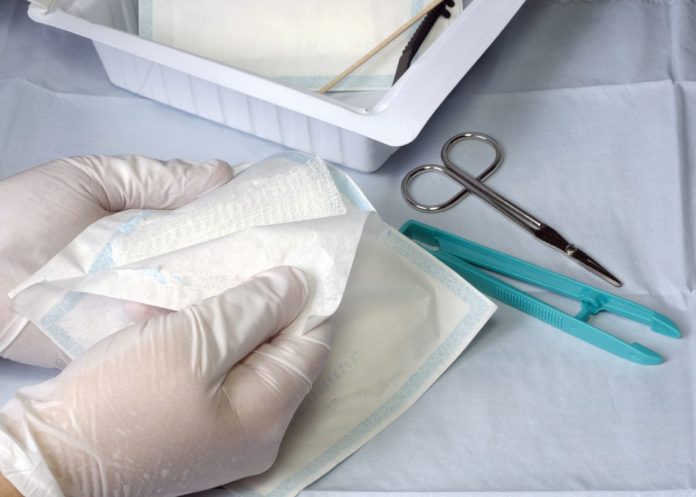Alexandra Bishop, Tissue Viability Nurse Specialist at Plymouth Wound Care discusses how effective wound care can make all the difference to a patient, and the NHS…
The importance of effective wound care cannot be underestimated. Wounds in complex patients and those that are poorly managed can lead to the development of a chronic wound. This subsequently results in a significant social and financial burden to the community and the National Health Service (NHS). Accurate cost is difficult to ascertain, but estimates from 8 to 10 years ago suggested that the cost to the NHS of caring for patients with a chronic wound was £2.3bn to £3.1bn per year, approximately 3% of NHS expenditure 1.
In 2009 in the USA, approximately 6.5 million people required medical intervention for chronic wounds at a cost of $25bn 2. These figures do not consider the social burden created by people with such wounds, including inability to work, mental health problems and the treatment of recurrent infections.
Wound care should always address the needs of the patient, promote normal healing and prevent complications. A priority in wound healing should be good communication. Dressings applied to acute wounds may require review by the patient themselves so clear instructions are necessary on what to do, when to do it and what should be raised as a concern. Surgical wounds are usually left covered for up to a week after surgery. In the case of graft donor sites, the dressing is left for up to 2 weeks. Discharged patients will need appropriate instructions to be sent with them regarding postoperative care and follow-up.
More complicated and chronic wounds involve the care of a number of health care professionals. Communication can easily break down when clinic letters are delayed or the patient misunderstands planning. Multidisciplinary clinic appointments are advantageous for more complicated wounds, such as diabetic foot ulcers which require input from a vascular surgeon, diabetologist/endocrinologist, podiatrist, orthotist and sometimes an orthopaedic surgeon. In areas where they are accessible, tissue viability teams provide nurse led expert advice on wound care and associated issues. However, many wound problems that occur could be prevented or addressed early in order to avoid chronicity developing. Therefore, a common role of tissue viability nurses is to educate and share expertise, not least on the wound care options available.
A host of innovations, dressings and technologies are obtainable for assessing, diagnosing and treating wounds with the list growing. They range from Doppler assessments to protease testing to topical negative pressure therapy to ultrasound treatments. Clinicians turn to more innovative applications and treatments for a variety of reasons. The concern regarding antibiotic resistance has led to an increase in the use of antimicrobial dressings including those impregnated with silver or poly (hexamethylene) biguanide hydrochloride (PHMB). Problems associated with surgical wounds dehiscing has seen the development of more compact topical negative pressure devices suitable for closed surgical wounds 3,4.
Although the National Institute for Health and Clinical Excellence (NICE) advise that there is no robust clinical evidence supporting the use of antimicrobial dressings 5, these applications are becoming more frequently favoured by clinicians and published case reports demonstrate a beneficial effect. All trials require financial support, which can be difficult to obtain and wound care studies are notoriously difficult to manage due to the individuality of patients and their wounds and the difficulty of blinding patients to the treatment given 6,7,8. Often this leaves case studies and case series as the best available evidence. Health care professionals subsequently use their experience and expertise along with the patient’s individual needs to select the care plan required. Ultimately, clinicians must have clear aim and objectives of care and select the treatment accordingly.
References
1 Posnett J, Franks PJ (2008) The burden of chronic wounds in the UK. Nursing Times. 104(3): 44-45.
2 Sen CK, Gordillo GM, Roy S, et al. Human skin wounds: a major and snowballing threat to public health and the economy. Wound repair and regeneration : official publication of the Wound Healing Society [and] the European Tissue Repair Society. 2009;17(6):763-771.
3 Hudson DA, Adams KG, Van Huyssteen A et al. (2013) Simplified negative pressure wound therapy: Clinical evaluation of an ultraportable, no-canister system. International Wound Journal.
4 Karlakki S, Brem M, Giannini S et al. (2013) Negative pressure wound therapy for management of the surgical incision in orthopaedic surgery. Bone and Joint Research. 2: 276-84.
5 NICE (2015) Wound Care Products. London: National Institute for Health and Care Excellence.
6 Bale S (2004) Using different designs in wound healing research. Nurse Researcher. 11(4):42-53.
7 Flanagan M (2005) Barriers to the implementation of best practice in wound care. Wounds UK. 1(3): 74-82.
8 Gottrup F, Apelqvist J, Price P et al. (2010) Outcomes in controlled and comparative studies on non-healing wounds: recommendations to improve the quality of evidence in wound management. Journal of Wound Care. 19(6): 239-268.
Alexandra Bishop MSc BSc RN(A)
Tissue Viability Nurse Specialist
Plymouth Wound Care
ali.bishop@plymouthwoundcare.co.uk











